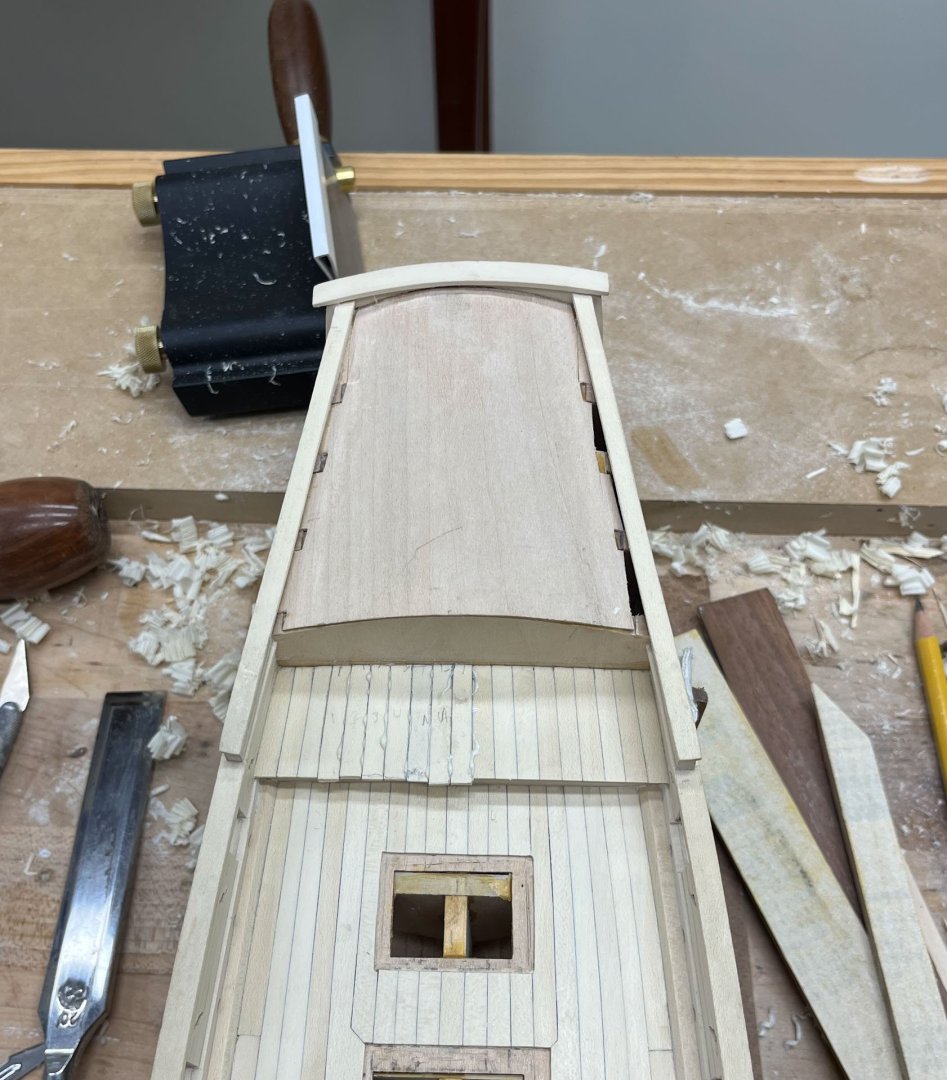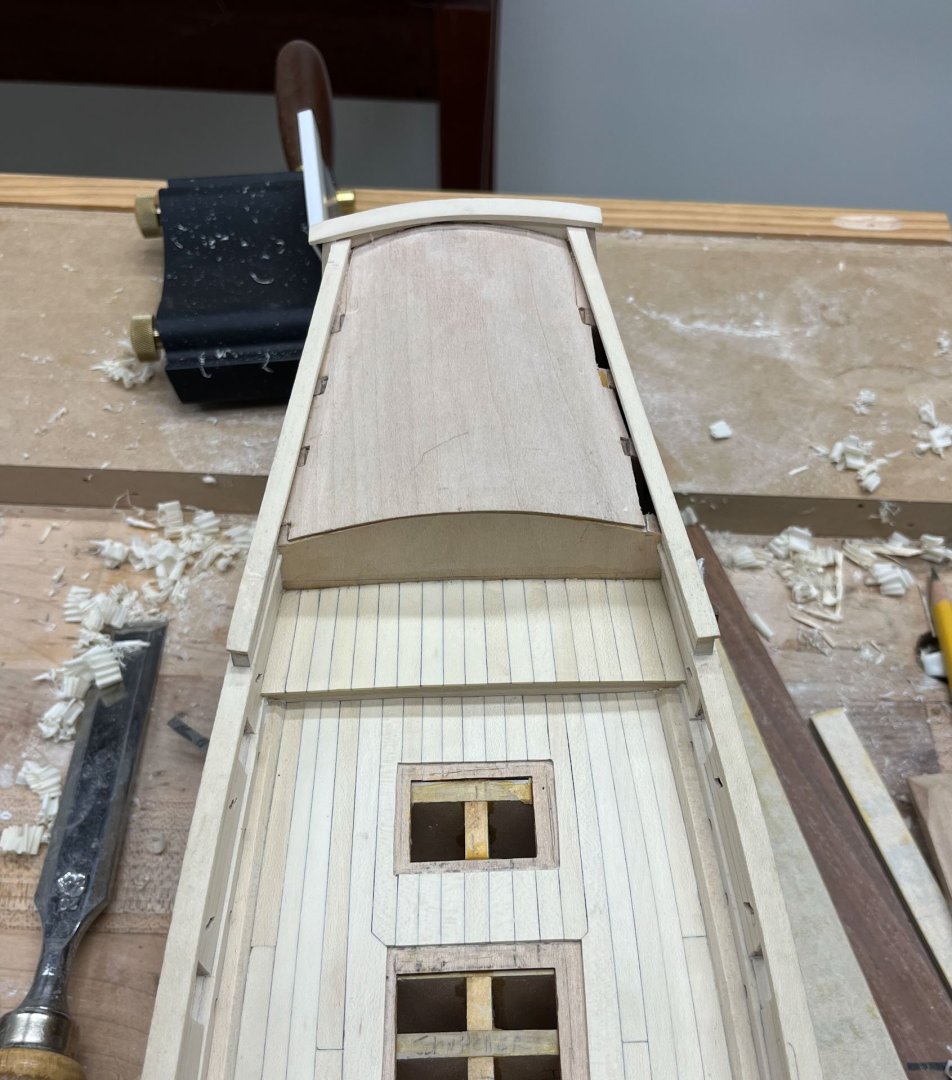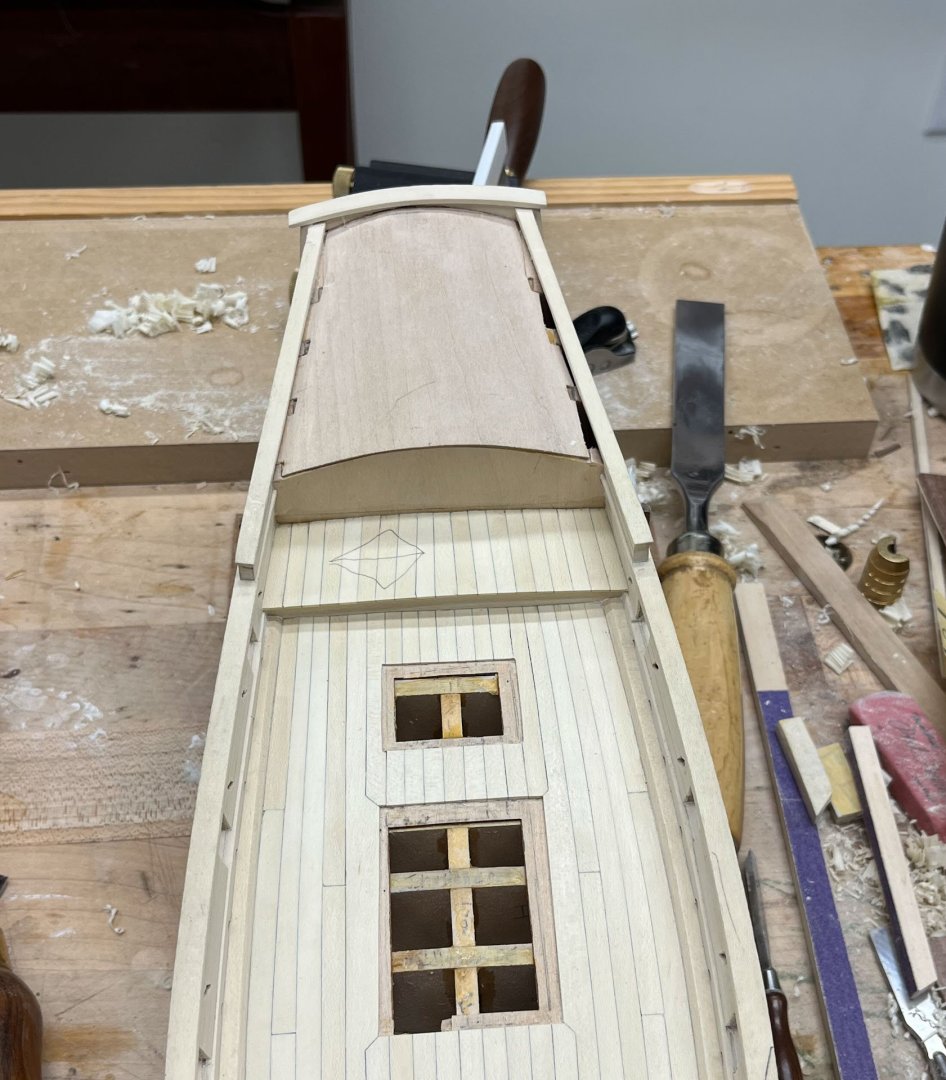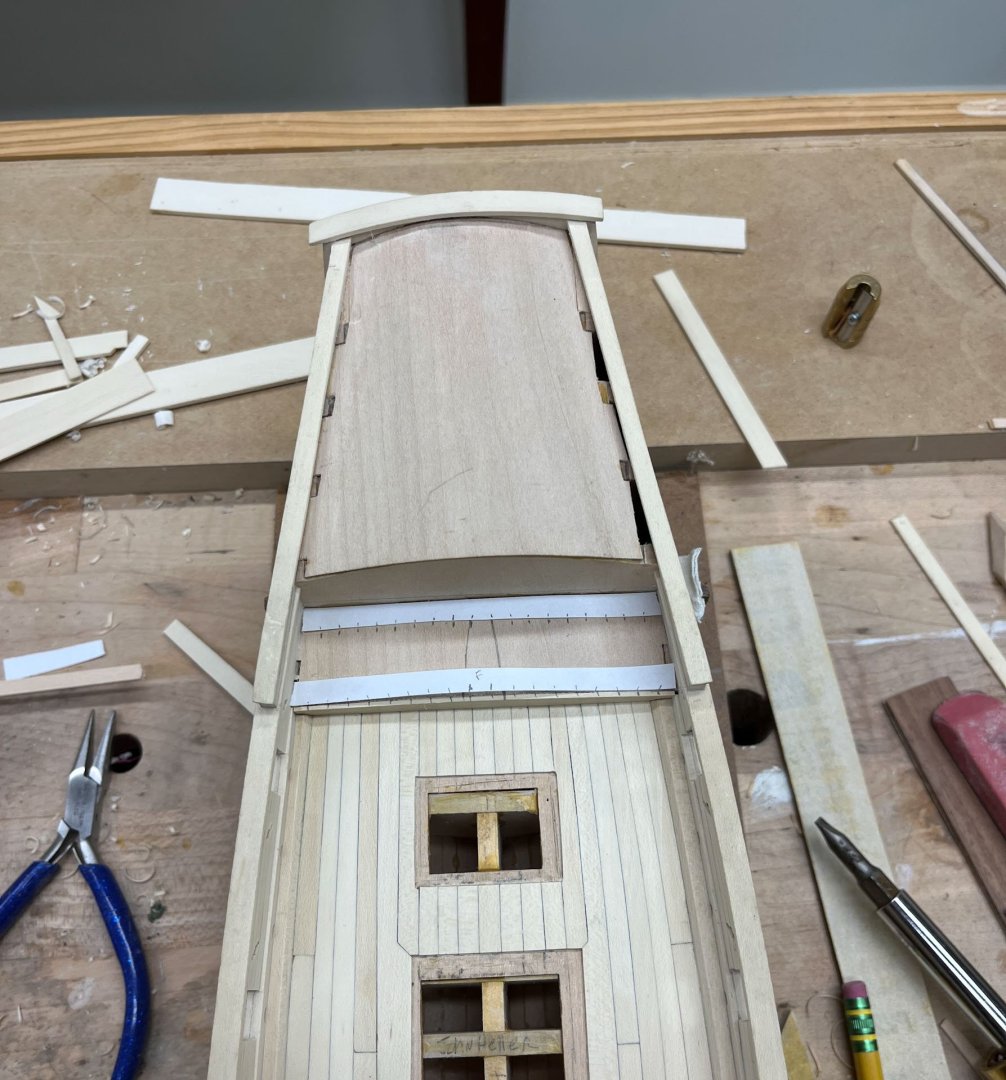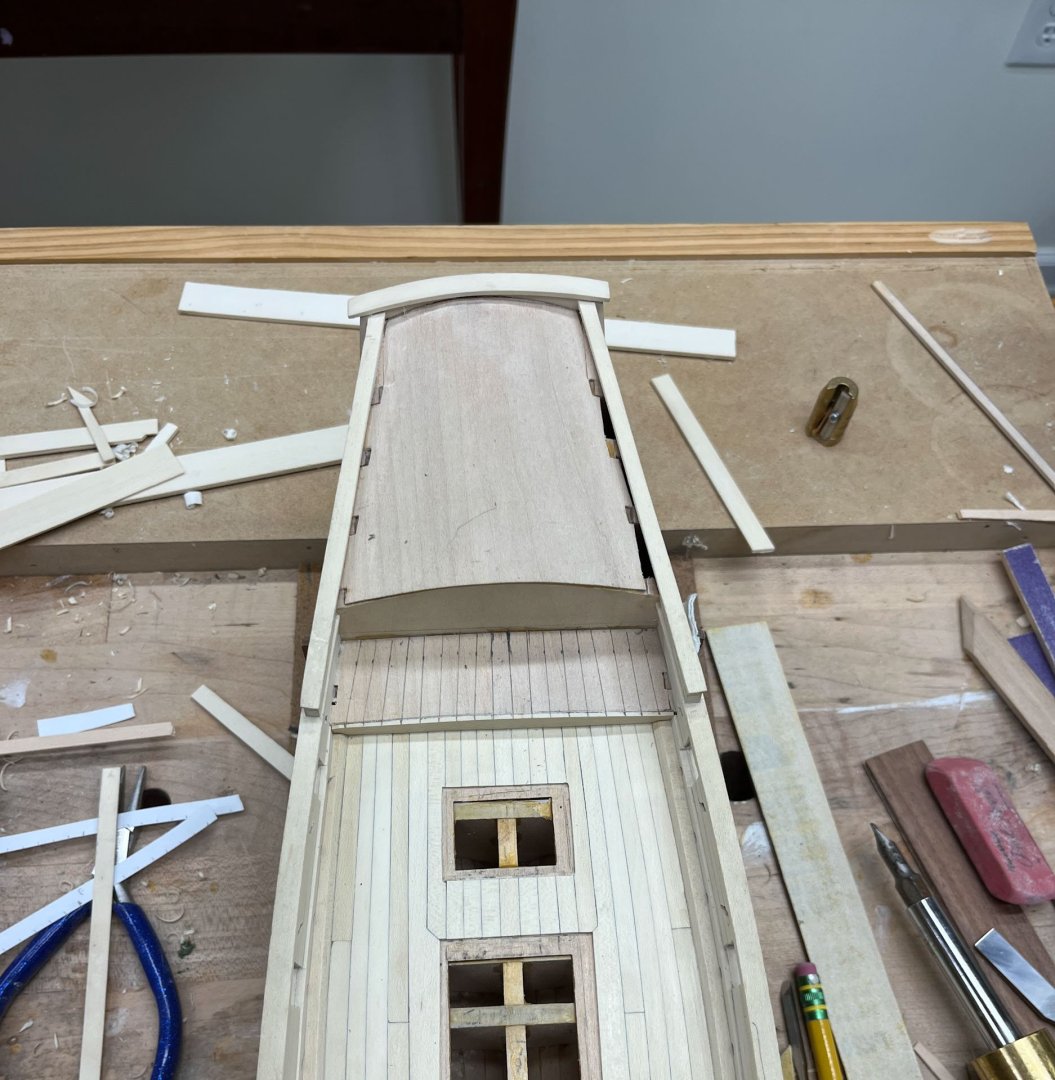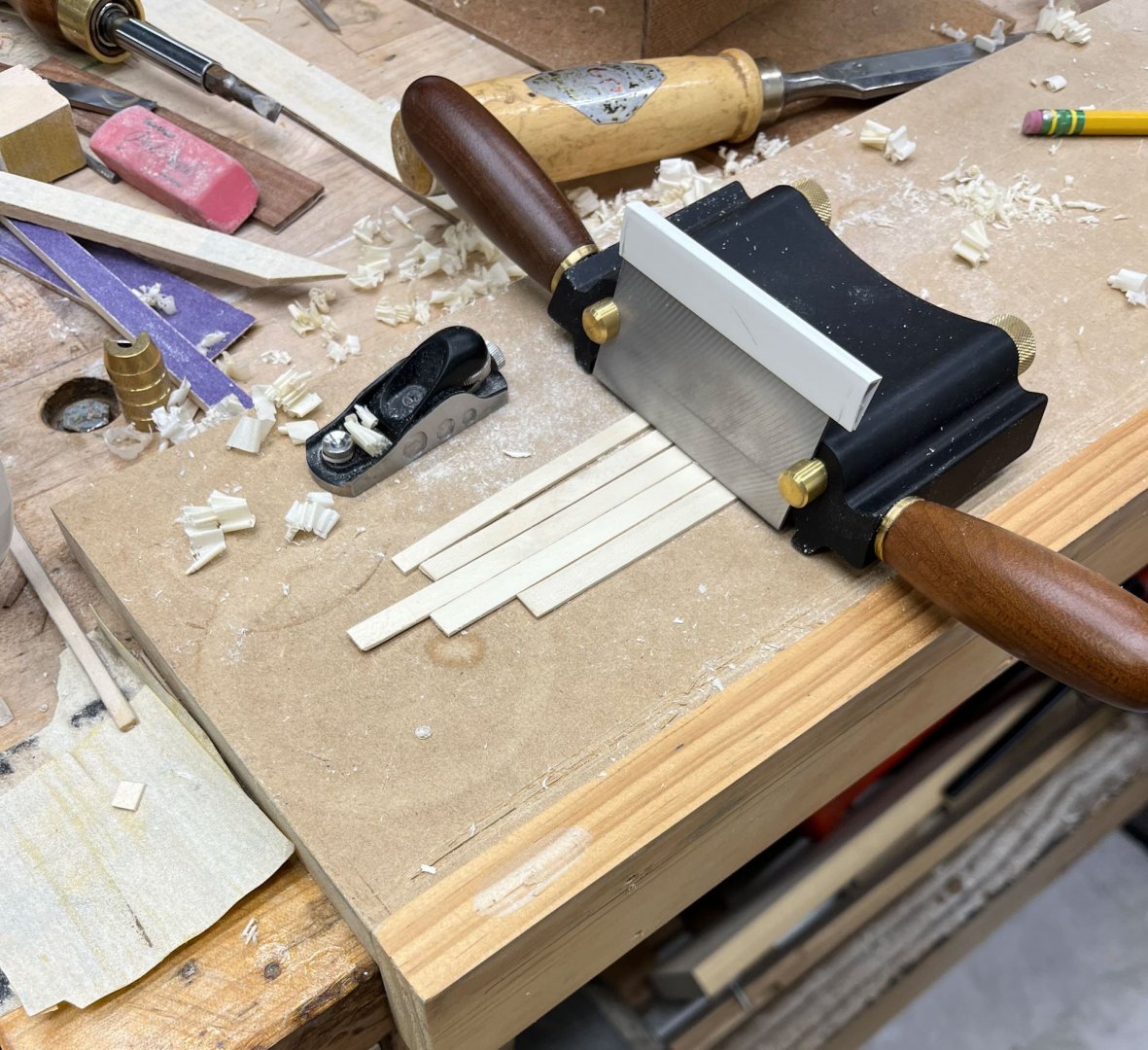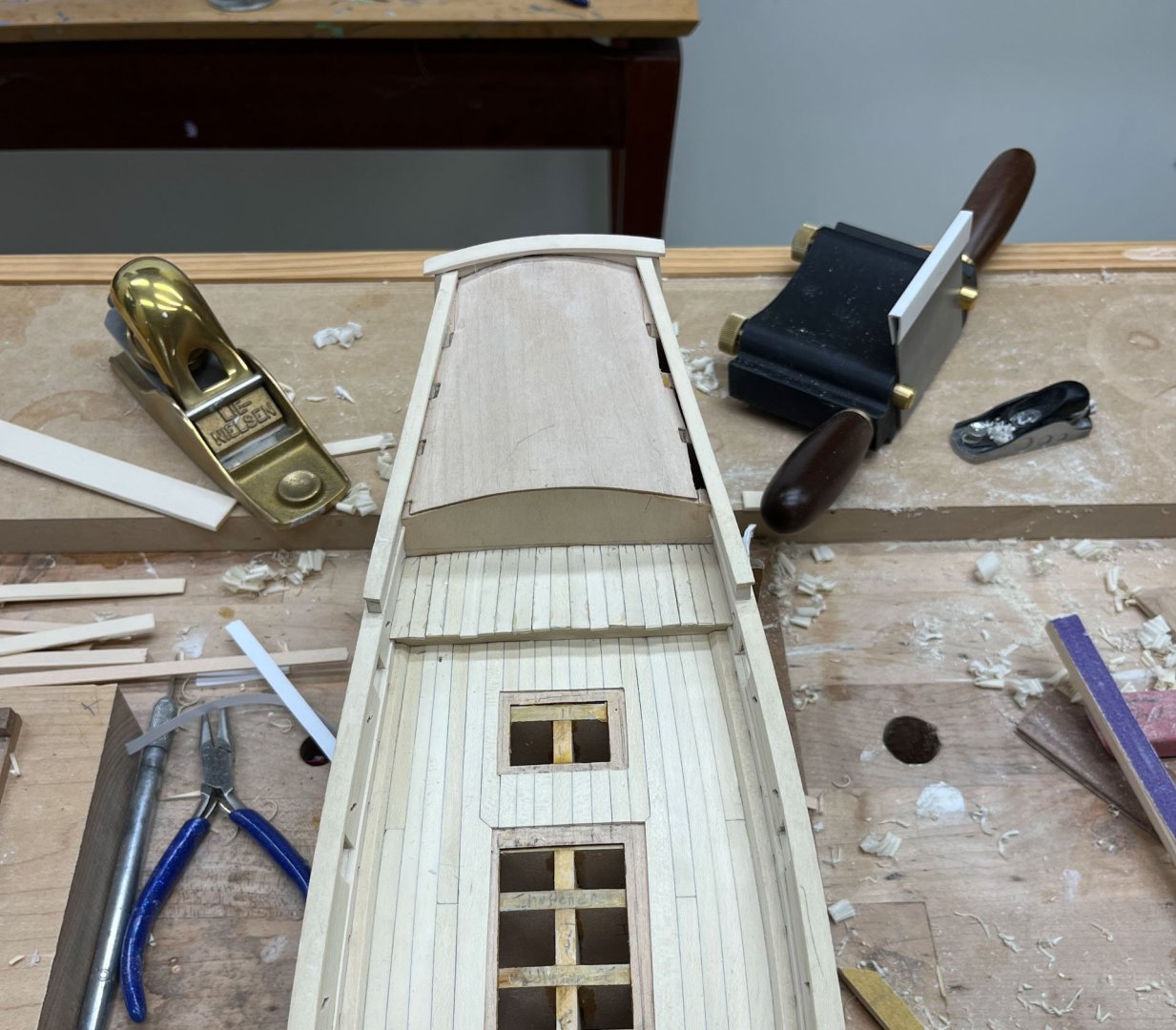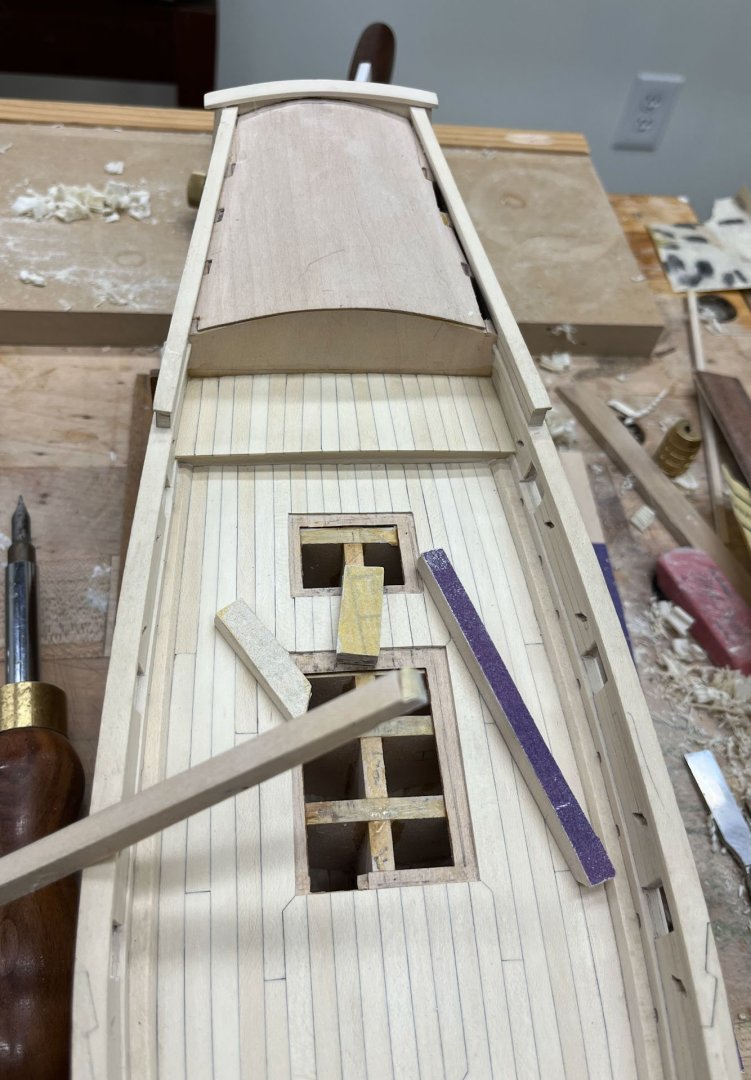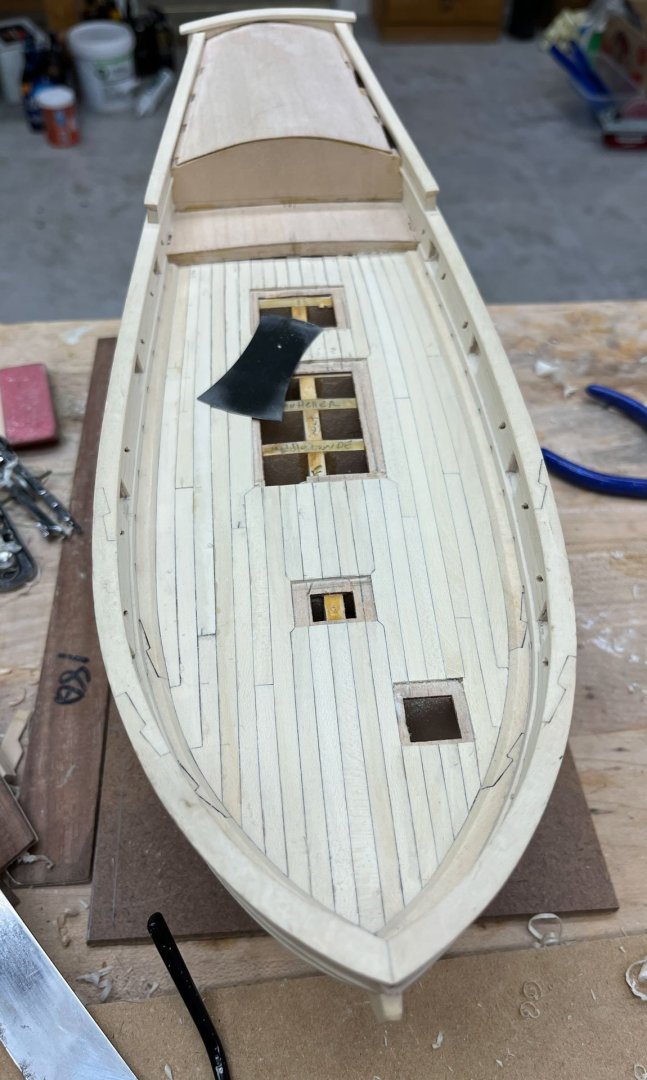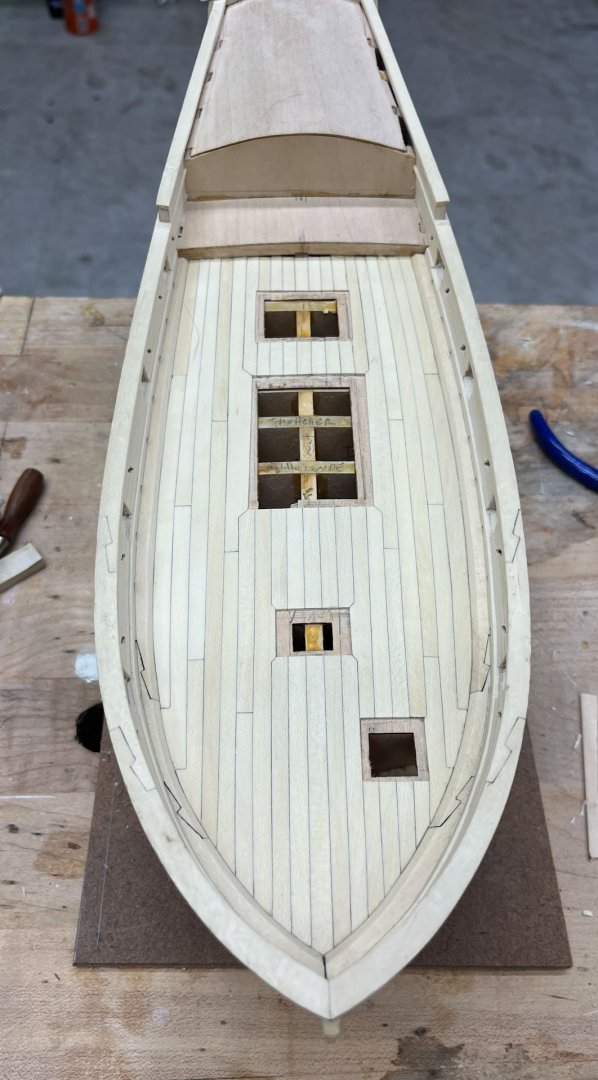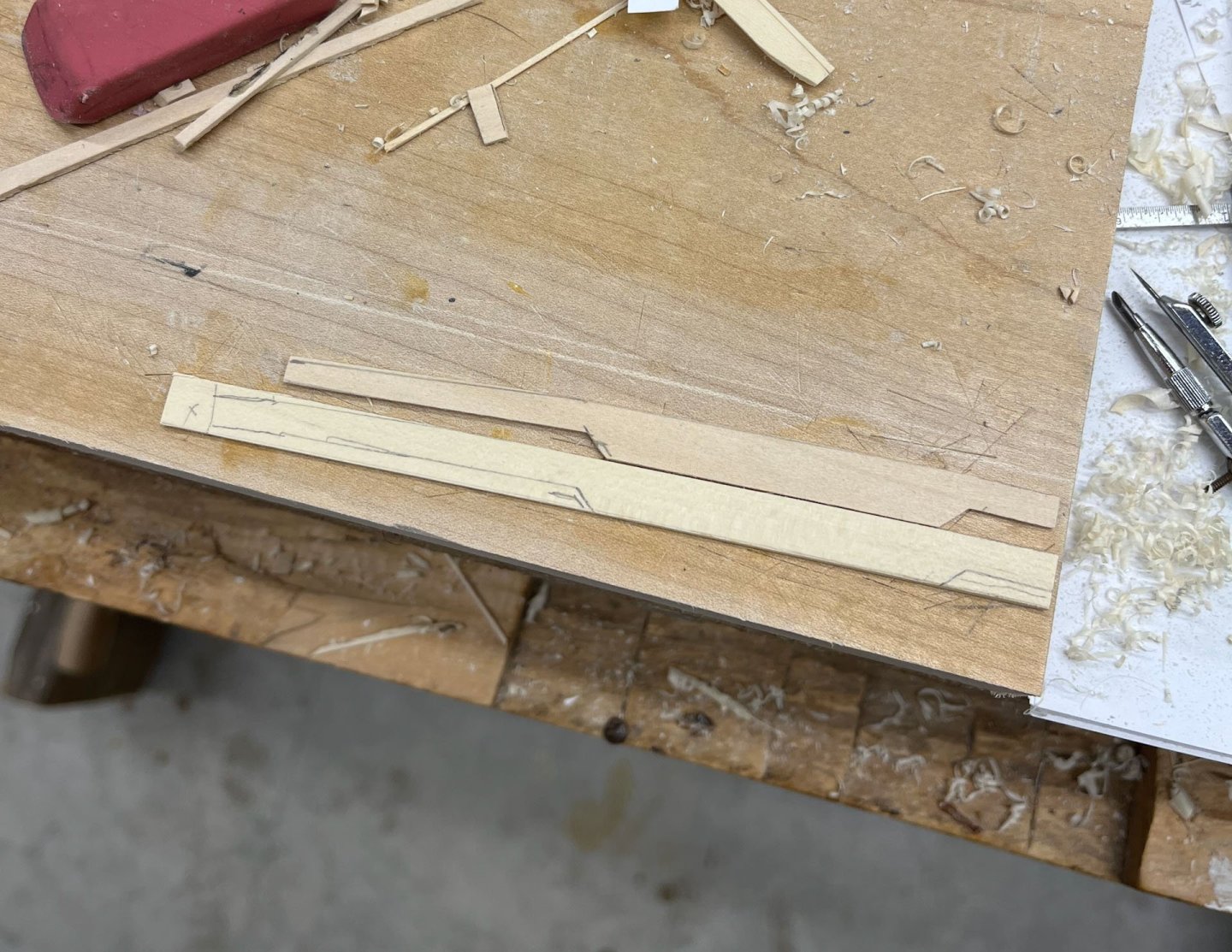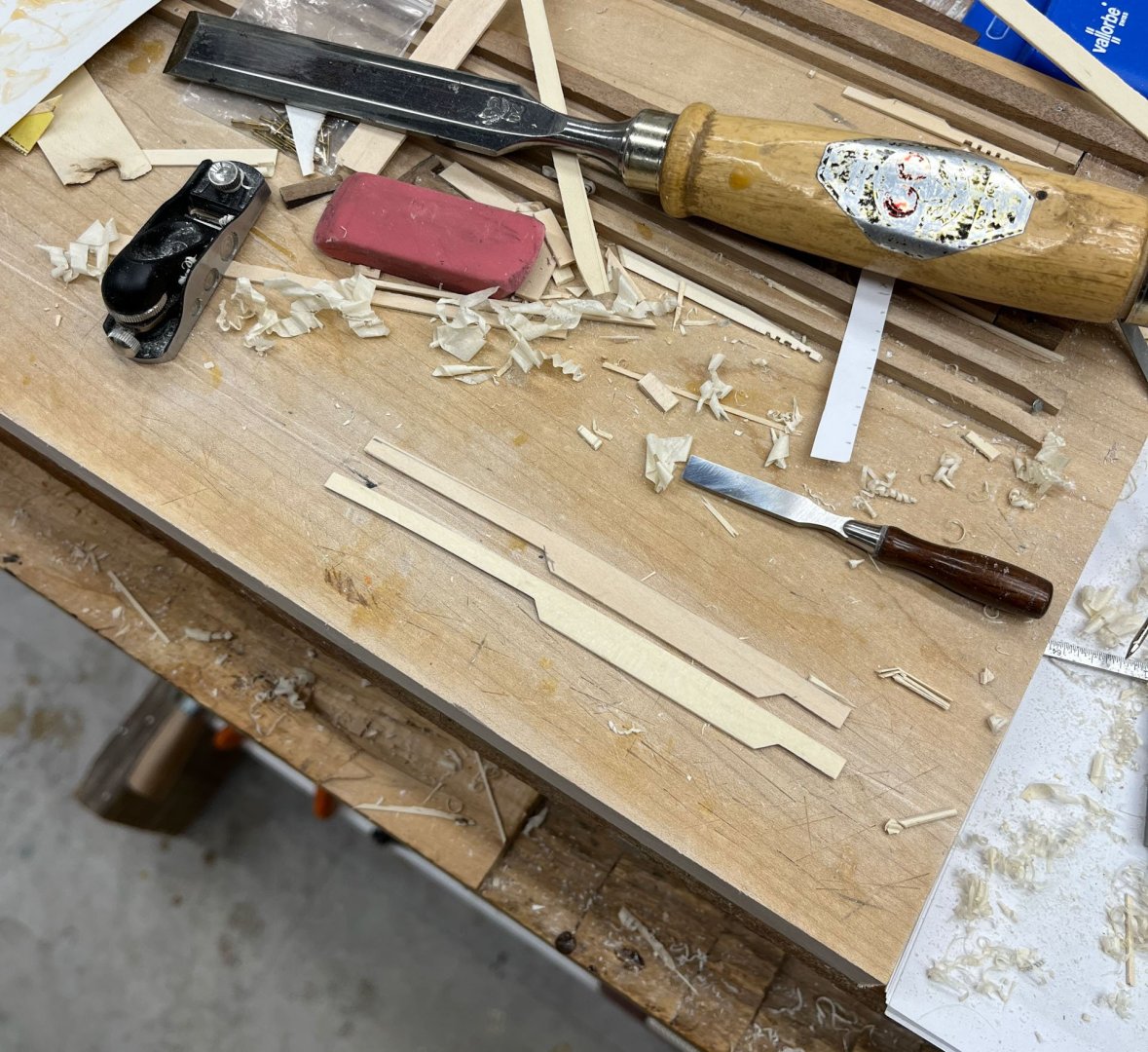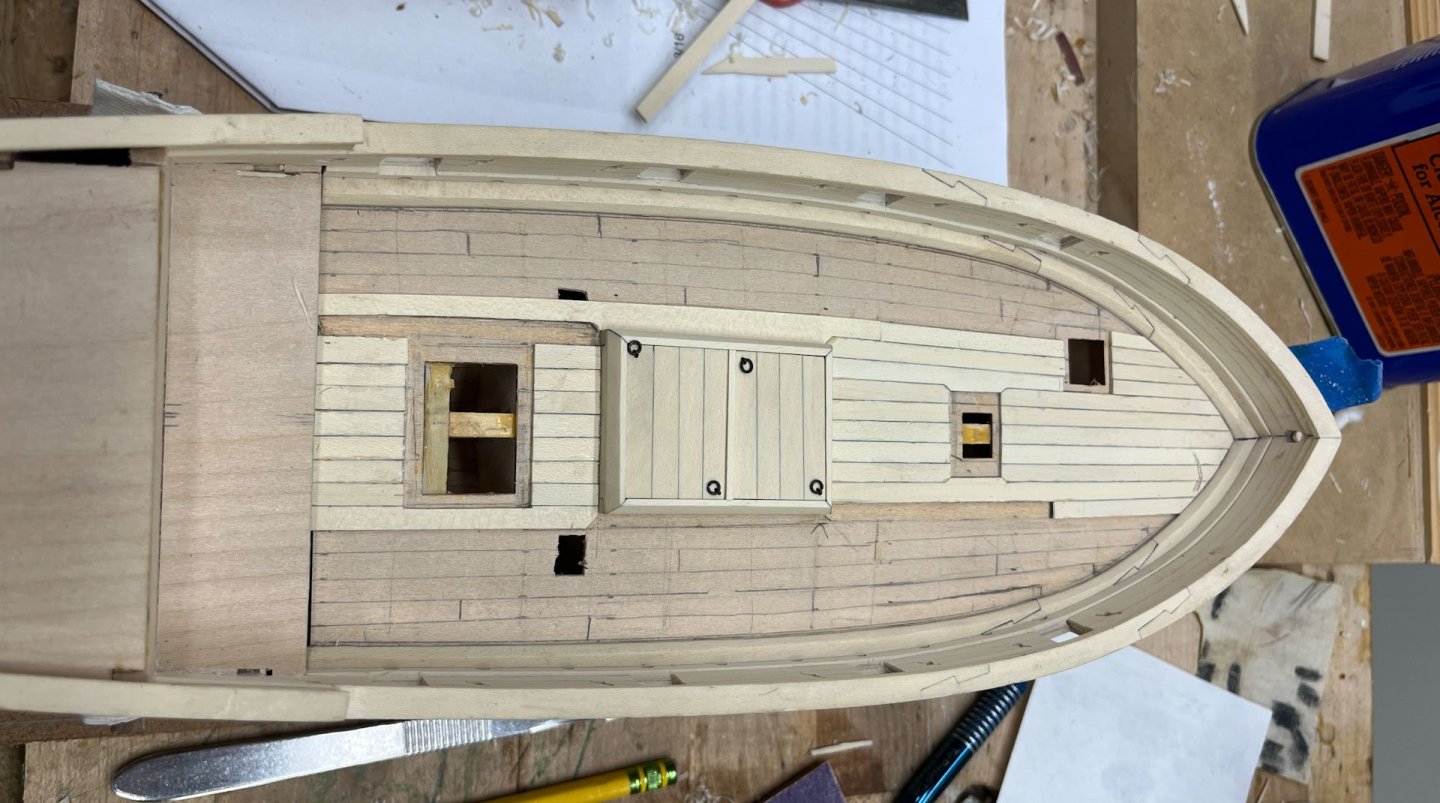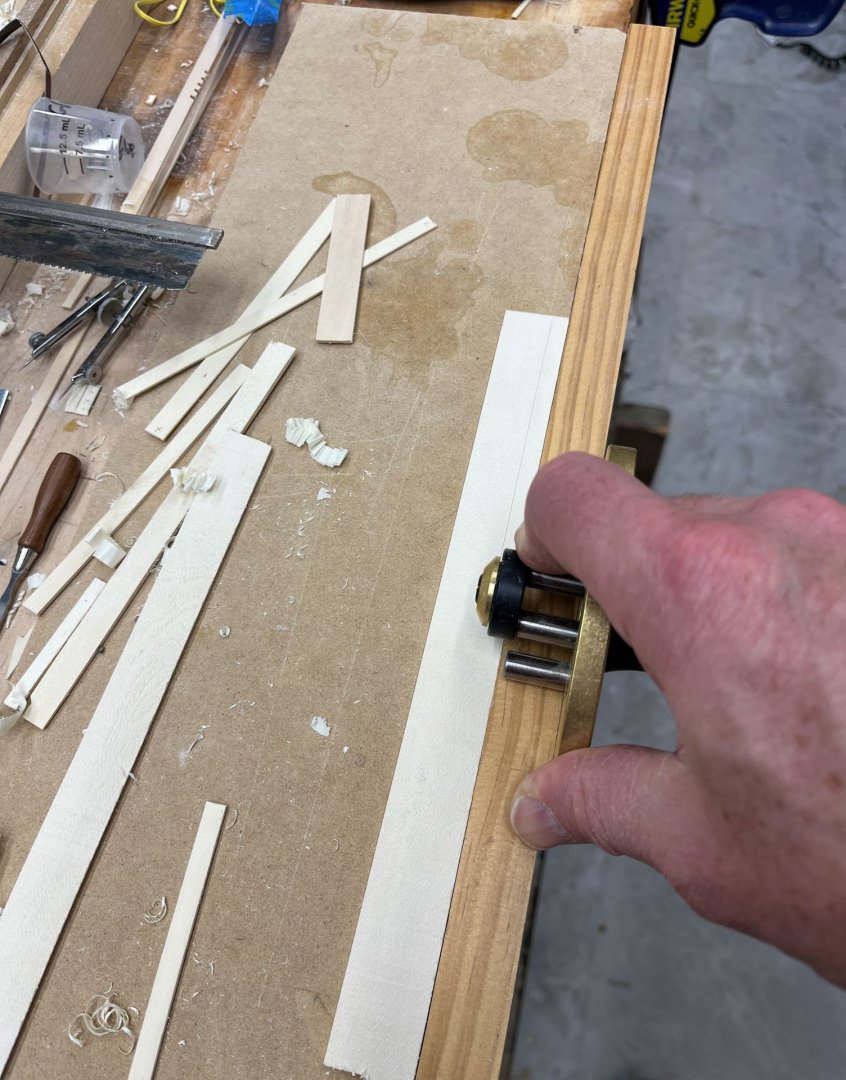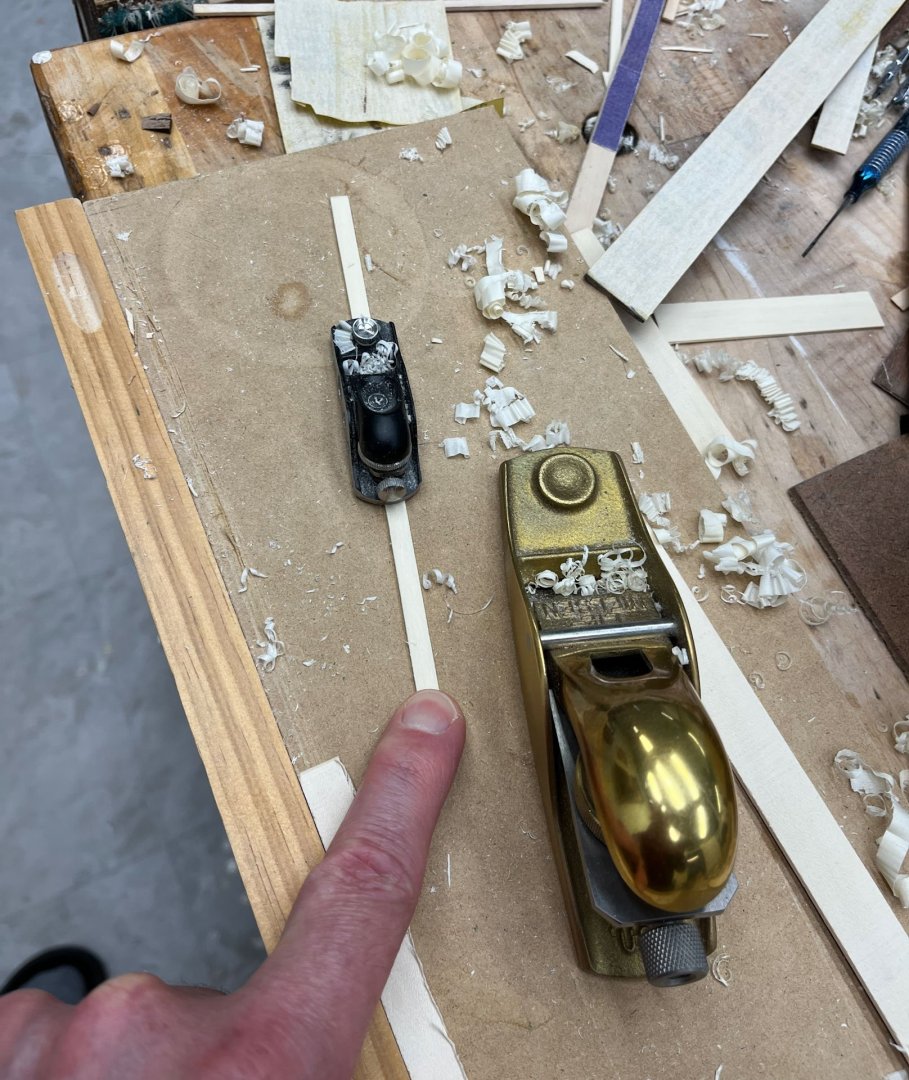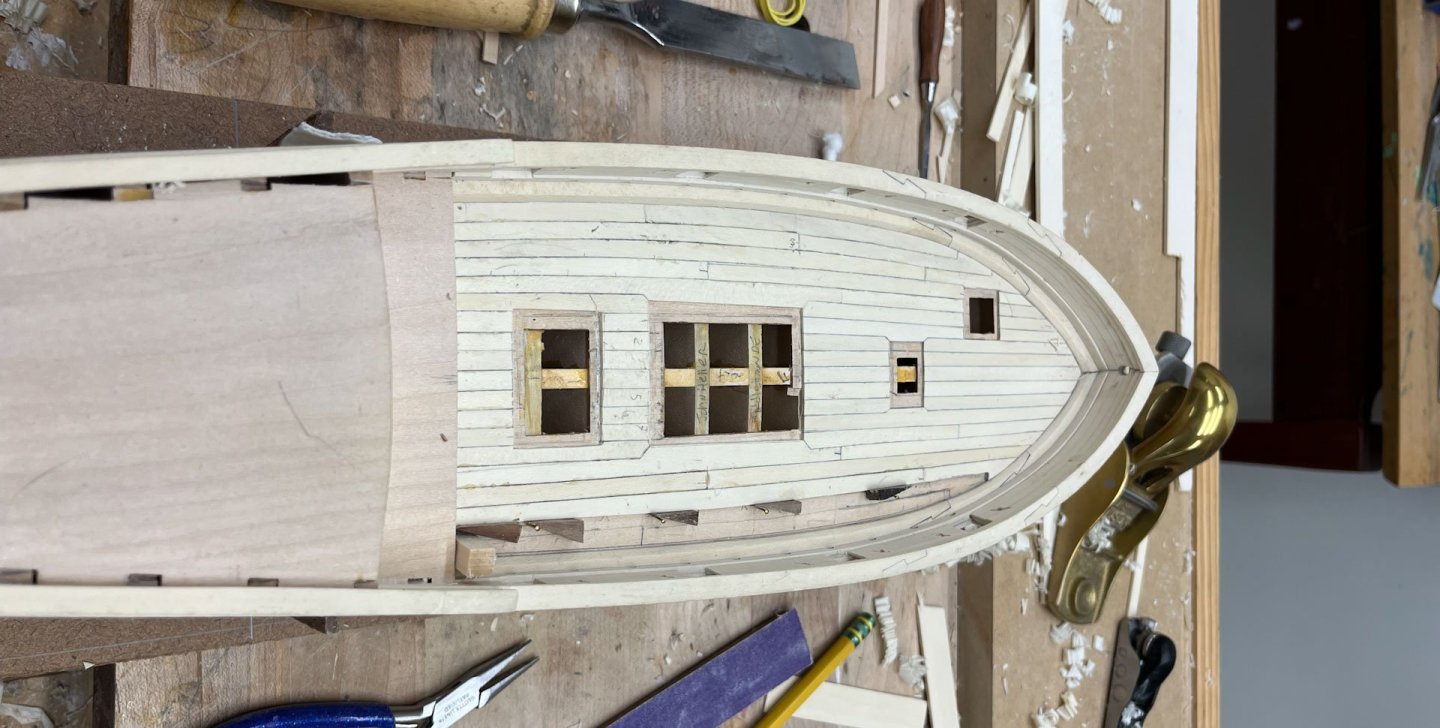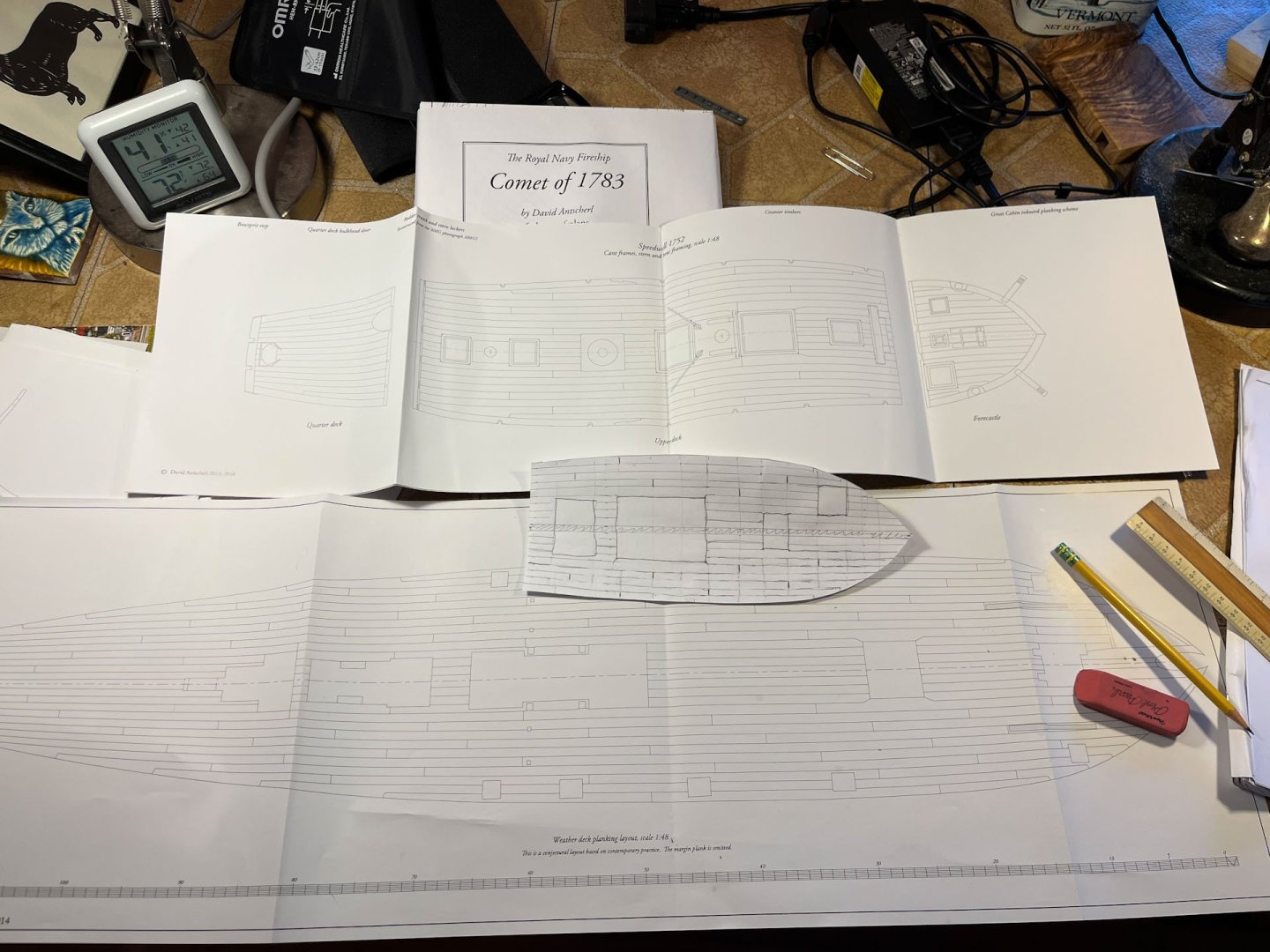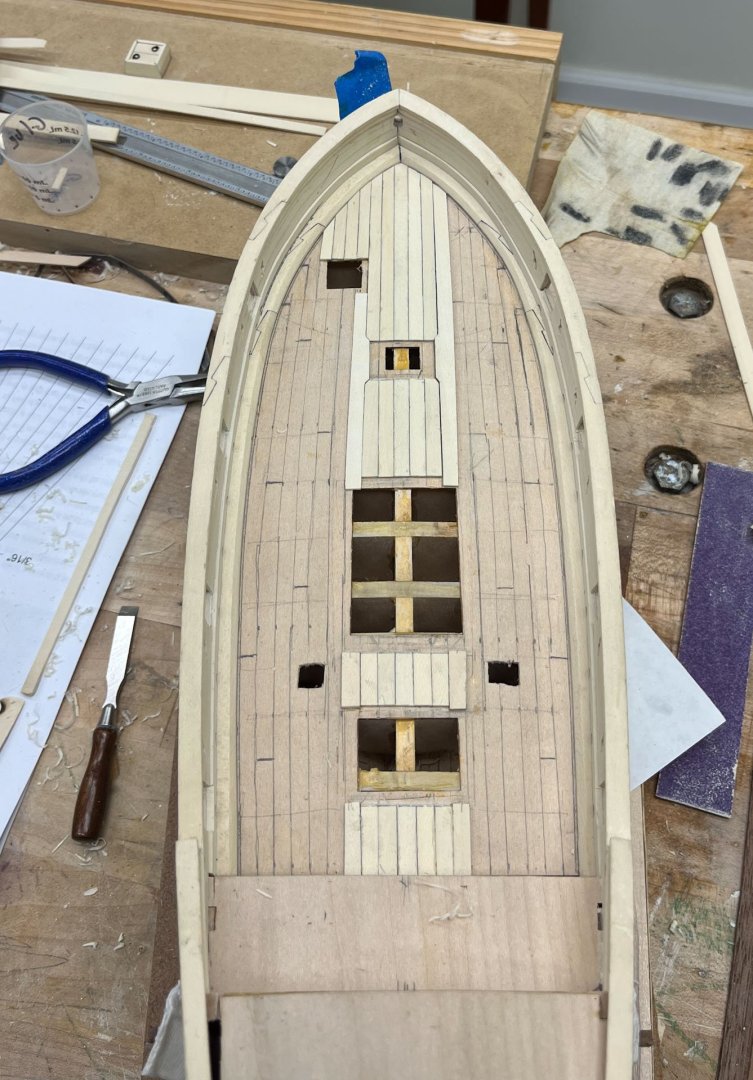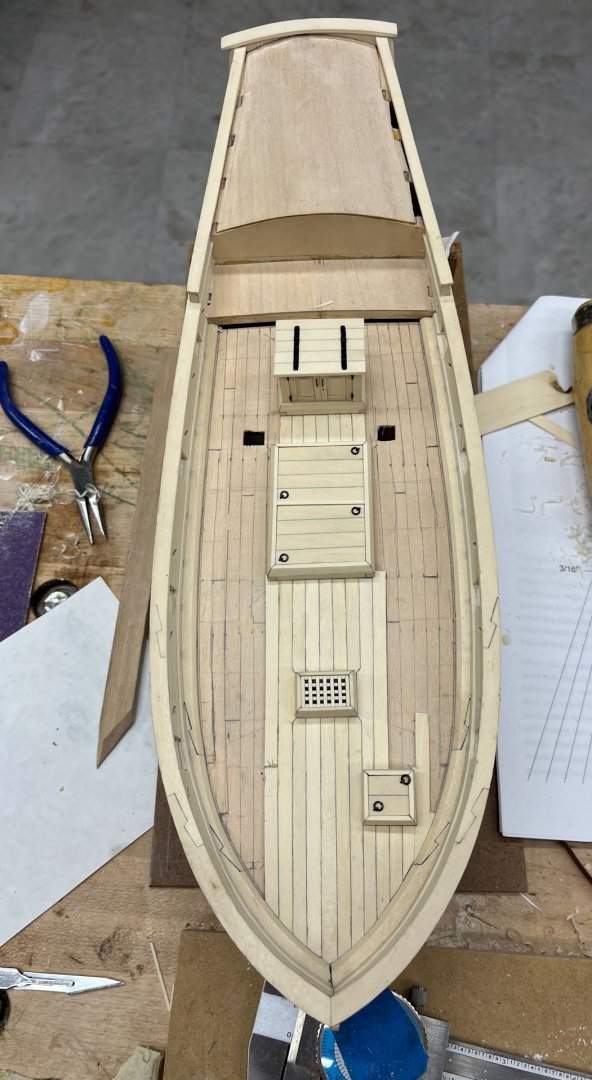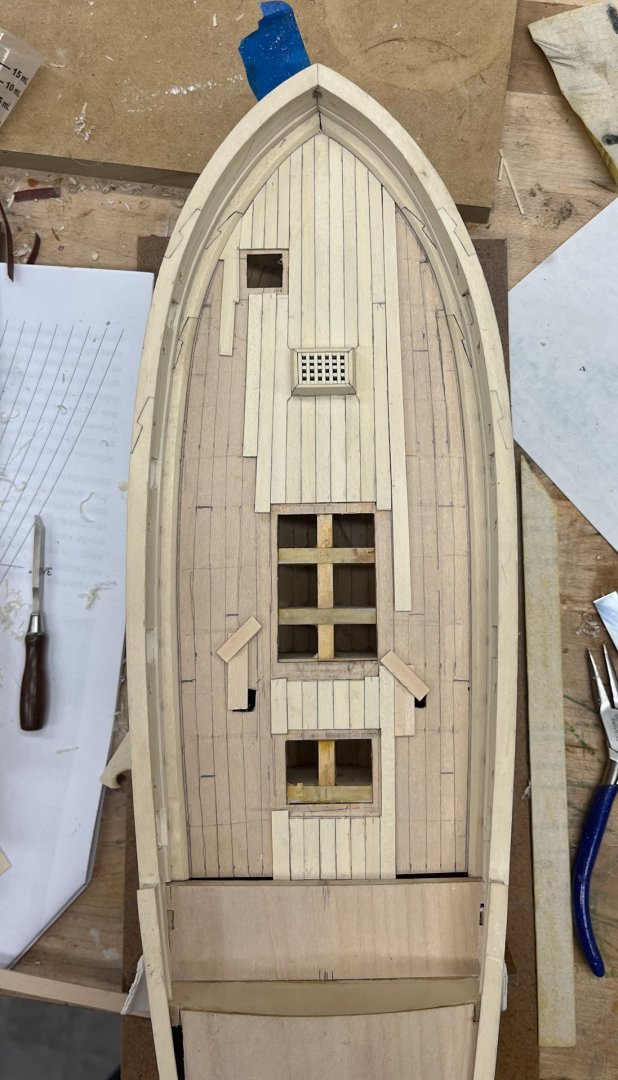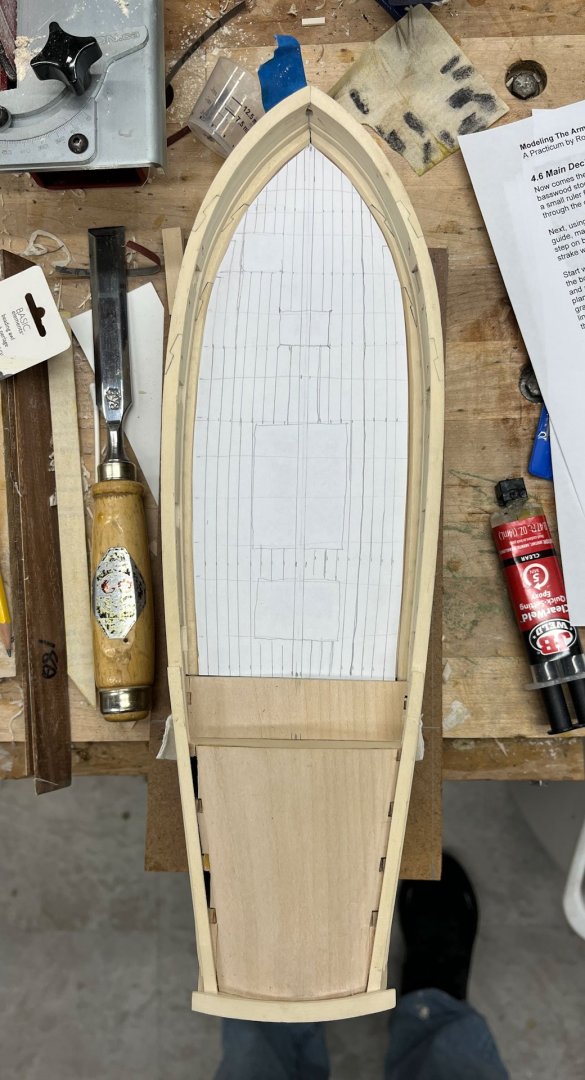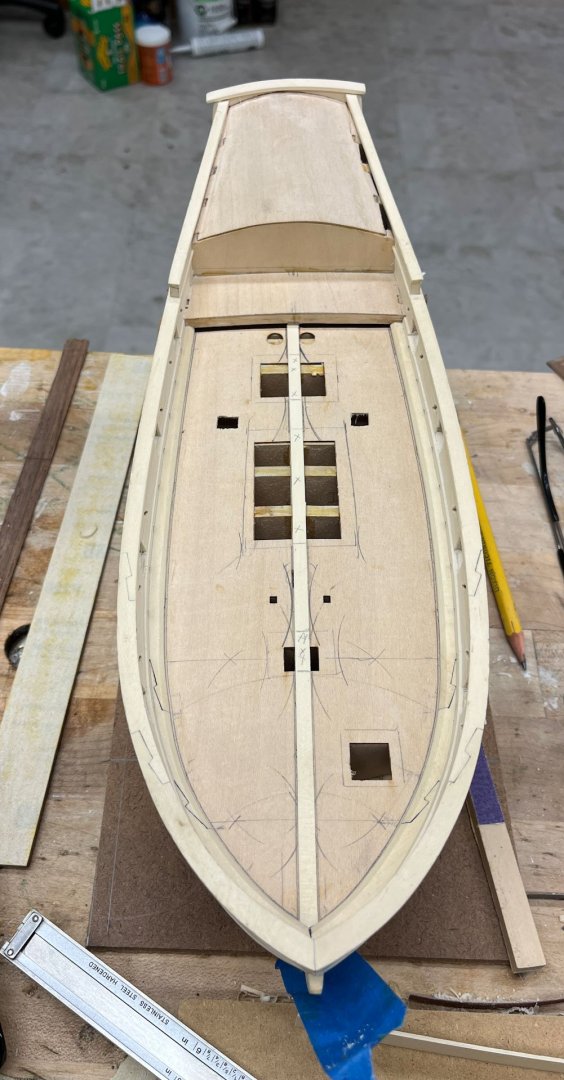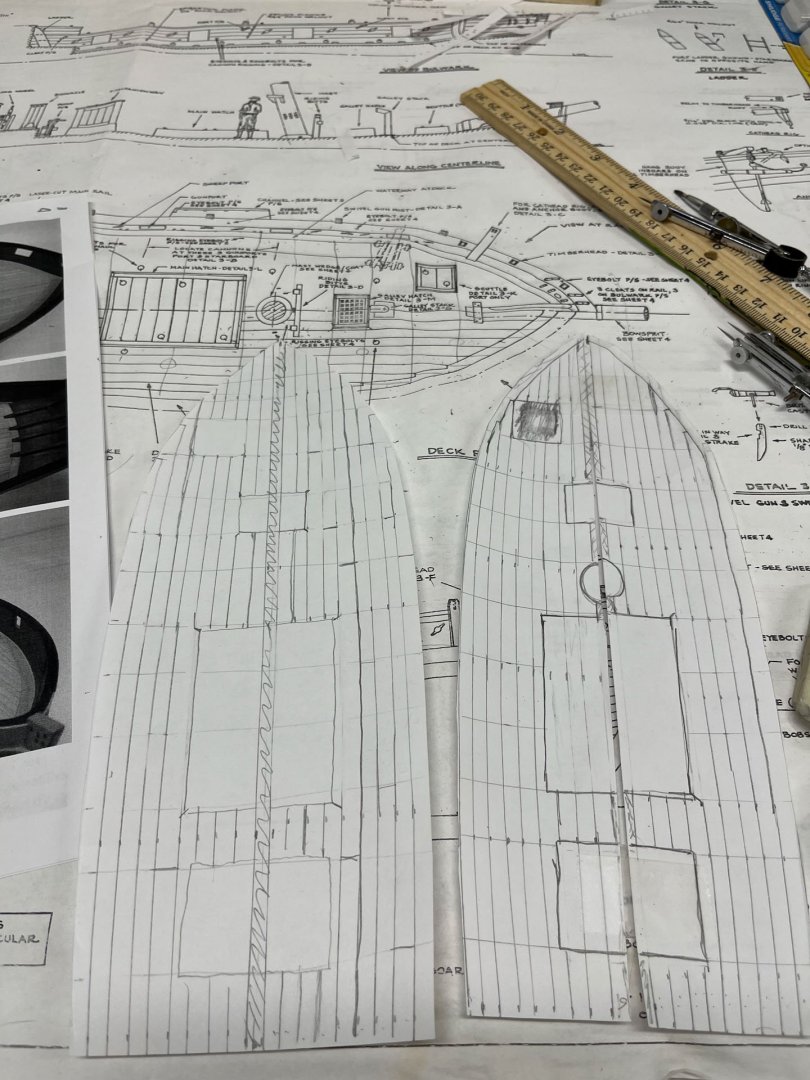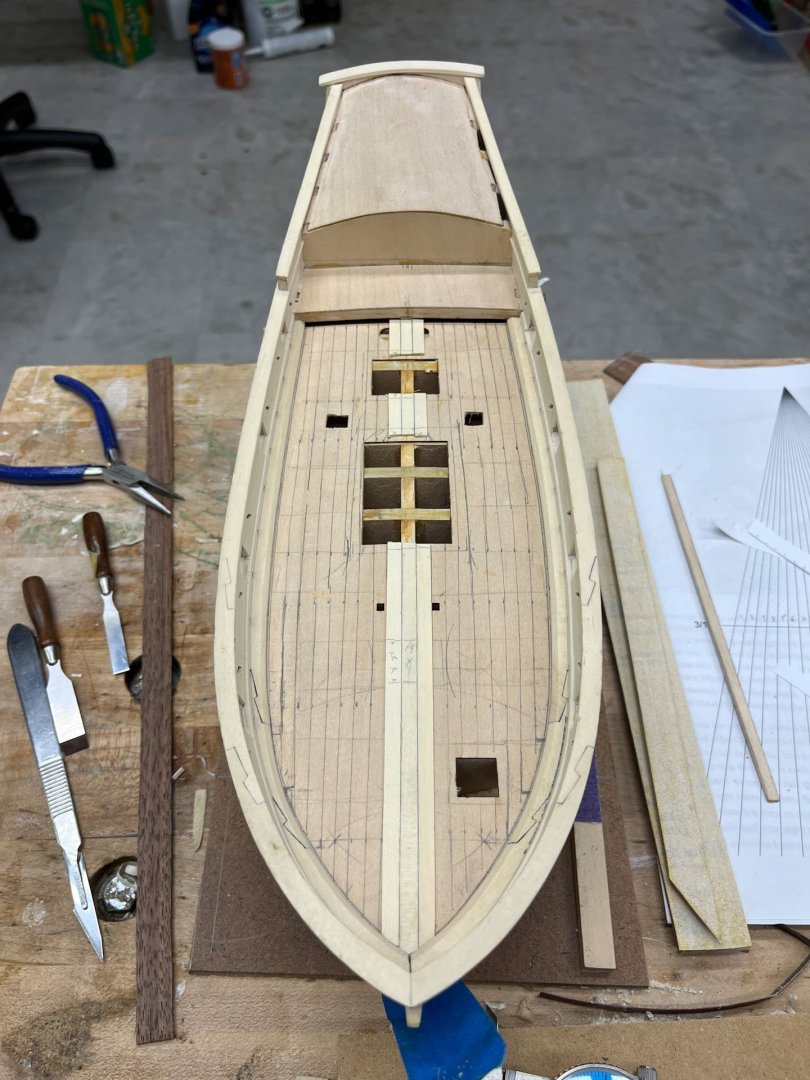-
Posts
379 -
Joined
-
Last visited
Content Type
Profiles
Forums
Gallery
Events
Everything posted by CiscoH
-
Well OCD (and a gentle shove from BE, thank you Sir) won out. I redid the quarterdeck. Here's the finished version of Quarterdeck #1. The starboard side is too uneven to leave be. I marked the offending planks. I ended up taking the center plank as well. I had purposefully made it wedge shaped so each side could fan out and I think I made the fore end too fat. Next some alcohol applied with a q-tip and gentle chiseling. The strips came out fine; at this point I am depressingly skillful at errant plank removal. I made some new planks (and did a better job getting them equal with the Inlay Thicknesser), redrew my planking lines, and then fitted all but the center plank. Last time I glued in the planks one at a time which seemed logical, but once its glued in you are committed. THIS TIME I placed all the planks in place, before glue, and thinned some of them until they looked more equal. It took several adjustments; a little extra width really shows up I guess because the planks are so short. Here are the new planks glued in place. Not so pretty. This round seemed to level really fast, to the point that the new planks were noticeably thicker when viewed from in front. I had to deliberately sand them thinner to make the edge even. And here is after 1 coat of poylurethane. To me the lines are much straighter; ironically I don't notice the lines really now, whereas the last effort the crookedness really stood out. Alright I'm glad I fixed that. Looks much better now. Ok, on to the cabin facade and doors. thanks for reading cisco
-
Brig Le FAVORI 1806 by KORTES - 1:55
CiscoH replied to KORTES's topic in - Build logs for subjects built 1801 - 1850
very nice as always Kortes -
Good Tuesday evening all In today's post I am planking the quarterdeck; all 2 feet of it. I wanted a fan-shaped pattern of decking which as you'll see didn't work out as well as I'd hoped. I also wanted to try out my Veritas Inlay Thicknesser. When I lay in the main deck my wood pieces started out a lot of different thicknesses. I used my mini-plane to roughly make them the same, but as I ran short of acceptable planks I used a few that were significantly thinner. It was much harder to bring the surrounding thicker planks down to the level of the thin ones and led to some unevenness of the deck which you can't really see but can feel if you run your fingers across it. So how to get planking that was the same thickness without the tedium of hand planing or scraping each piece and measuring every 2 inches with a caliper? (and no for now I am not buying any powered devices. I want to learn to do it by hand first). I had bought the Inlay thicknesser a while ago but it had to be sharpened which was Work so I had put it off. No longer! The instructions have you make all the planks all the exact same width, except the 2 side ones trapezoid to fit the last uneven space to the hull bulwarks. My eye was always drawn to these edge planks as looking uneven so I tried a fan pattern. (The Fore part of the quarterdeck is slightly wider across than the Aft portion.) First I broke out my tick strips and measured the front and back of the tiny quarterdeck. Then I drew in lines for each plank. This looked slightly wonky to my eye but I figured I could adjust the lines some as I put in each plank to make them look more regular. A lesson here - if the plan is off and you accurately build to the plan then the build will be off too. I should have redrawn some of those lines. Now to make even thickness planking. I quickly discovered the Inlay thicknesser couldn't remove much wood at a time. It worked best when you shave the stock to Almost Thin Enough with the miniplane, then use the scraper to bring it to final thickness. The planks weren't perfectly the same thickness but they were a lot closer than before. I added all the planking one at a time and used a pencil to indicate caulking and yellow glue, same as before. Here it is before sanding and evening the edge: And here I have sanded it flat (180 -> 220 grit), leveled the edge, and removed some glue squeezeout that formed underneath the overhang (which was a pain to get at), and applied 1 coat of water polyurethane. I put all the oddly-shaped sanding blocks I used onto the deck so i remember them in the future. It looks ... ok. My fan shape didn't "fan" very well. I like the port side but I may replace some the middle starboard planks with better shaped ones. The wheel assembly goes directly on this deck so it will probably hide things but I'll have to see what my OCD does overnight. Your eye really picks out Not Parallel lines. Well once thats resolved next up is the entrance facade to the cabin. I'm thinking flat paneled doors are boring; maybe doors with lower raised panels and upper windows? thats it for tonight, thanks for reading, Cisco
-
Brig Le FAVORI 1806 by KORTES - 1:55
CiscoH replied to KORTES's topic in - Build logs for subjects built 1801 - 1850
Glad youre back Kortes! Lovely work -
I think it took me 3 months to plank my hull. Amazing job Mr Ensign it looks fantastic
- 332 replies
-
- Harpy
- Vanguard Models
-
(and 1 more)
Tagged with:
-
Good Evening MSW! Here in Delaware its snowing like crazy. Time for Main Deck Planking update #3. I got the last main deck planks in. No new surprises once the hooked ones were fitted. Only sad part is all the deck furniture will hide most of it. Here's the initial finished state. Some glue smudges, a lot of pencil marks, and the uneven thicknessed planks make it look pretty rough. I tried using this tiny scraper I got a while ago. It works surprisingly well - no tearout atall and it did the port side of the deck great. But after a lot of tiny shavings and not much progress leveling the more uneven planks on the starboard side I switched to small blocks of wood with 180 grit sandpaper. That got it leveled fine, so i switched to 220 grit, vacuum again, and first coat of water based polyurethane. I'll do another coat of polyurethane tomorrow and then move onto the cabin planking. thanks for reading Cisco
-
Thanks Hamilton. The bigger brass plane is from LieNielsen, the tiny one is from LeeValley. The marking tool is also Lee Valley- a string inlay cutter. Very heavy duty and astoundingly cheap at 115$. I use it and the tiny handplane (and their mini chisels) all the time. https://www.leevalley.com/en-us/shop/tools/hand-tools/inlay-and-veneering-tools/69874-veritas-string-inlay-tool-system
-
Good Sunday evening MSW. Another plank-the-deck update. I thought I'd recap my plank preparation technique. I have 2 billets of holly that I have cut aprox 1/8" thick slices from. These are rough on both sides and too thick to directly plank with. I don't have any sanding or thicknessing machines (and regardless prefer to do it by hand anyway). To cut my planks I use the below device to slice off a strip a bit wider than what I need. I really like being able to control how wide my planks are, as opposed to getting pre-cut planks that are all uniform. After cutting off a plank I thickness it with my handplanes; basically a few strokes on either side to remove the roughness of the bandsaw. Holly seems to be very forgiving and gives a glass-smooth surface even going against the grain if the tool is sharp. I hold the one end with my finger while planing; it pays to leave the strip long to start so you have more to grab onto. Both edges are planed in the same manner to get them pretty close to square; I also use sandpaper attached to thin strips of wood for final shaping. The long straight planks are easy. The tough ones are the wide miters and the hooked scarfs. After several holly discards I started making the weird shapes out of scraps first. This one was especially tough- a mitered section incorporated into an overall curved plank. But once I got the test piece done it was easy (well, a little easier) to trace it onto my holly stock and trim it close, then fine tune the fit. And here it the final holly piece after fitting. I hope it can be seen the whole plank curves as well, so you have to fit the 2 miters while fitting the curved section. I found it plenty challenging. And below is that piece glued in place on the port side of the main hatchway. But. As I mentioned before my main hatchway is a trapezoid, not a rectangle. I kept getting gaps that were driving me knutts until I turned the main hatchway 180 degrees and it overall fit better. Except now the port back miter was off a little so in the below picture I have removed the offending plank and once a new one was fitted it looked much better. But that now emphasized how off the rest were so the whole row of short planks clearly had to go. I think I've planked this deck 3 times by now. The miters around the main hatchway are (a little) different sizes but its as good as its gonna get; time to keep moving. And here's where we stand tonight. Some of you may be able to form planks perfectly so finger power alone holds them in place. I still like to place brass pins and wedges, like I did on the hull, to tighten up any "gaps." Once all the planking is in I will scrape it flat, then sand and finish it with water based polyurethane like the rest of the ship. Then its on to planking the cabin which will have NO HOOK SCARFS or MITERS. thanks for reading cisco
-
USS Constitution by mtbediz - 1:76
CiscoH replied to mtbediz's topic in - Build logs for subjects built 1751 - 1800
i personally like the dark grey better. Maybe a mix of the 2 paints? -
Fascinating Dan! thank you for posting all your research. i visited the barge in its museum a few years ago and you really have to see it to appreciate how enormous the whole thing was. hard to believe it was laced together
- 22 replies
-
Tonight is another mid-flight deck planking update. I had thought I was done with the Thinking Part but Lo I was mistaken. I was still happy with the curved outside and straight inner planking run. Then I tried to figure out my butt shifts. The Model Shipways AVS plans don't have any butts, the easiest way to deal with them I guess. I measured my hull planking and the longest plank was 7", or a scale 28' long, and a 3-butt shift. So I decided on 7" long decking, no problems, but what about keeping the hooked scarfs from being too long and not having butts in awkward places? A lot harder than it first seemed. A week later, after studying Cheerful, Comet, and Speedwell's plans and a lot of erasing I settled on a) 4 shift pattern, and b) where this pattern would start. This first butt of course dictates where all the other joints will be and I didn't want odd 2 foot planks at the ends OR a joint right next to the various hatches. (As an aside, I have been thankful I purchased so many of David and Greg's books AND plans, even if I never end up building those specific ships. They have been vital in helping me think through so many different tasks like this one.) I also had to figure out how to integrate the planking with the hatches and coaming. The fore grate is surrounded by notched planks. Fitting the next outer plank so it slides into the notched areas took some slow repeat sanding and many fittings but went ok. The port side went fine as I could leave the front end long and trim it later; the starboard side had to be fitted to the notches AND into the curved waterway. Pictured is my second attempt- it was all too easy to oversand the pointy part and leave a gap like I did here. Third time worked out though. Also shown above is me using the wrong wood. Both outer planks (the short ones) in the middle section are basswood, which is very hard to see. I realized it last night and replaced them no problems. The colour is very close! Here is a pic of the deck with most of the furniture in place. The big central hatchway is not square, its more of a trapezoid. At the time I didn't want to remake those darn mitered half lap joints and as usual its come back to haunt me. You can see the hatch skews to port a little when lined up with the decking (its even at the back, which can't be seen in this photo). One of the upsides of the basswood planks mistake was the opportunity to replace it with a wider one to help compensate. The fore grating fits well so now I'm notching around the companionway (which is thankfully actually square) and the large hatchway as my next steps. I made some jigs to help with notching 45 degree joints (laying on the deck above) with more accuracy as I eyeballed it my first go around. Well thats it for today. Happy Holidays MSW! thanks for reading, Cisco
-
ancre La Salamandre by tadheus - 1:24
CiscoH replied to tadheus's topic in - Build logs for subjects built 1751 - 1800
welcome back Tadheus! -
great planking job. dividing the hull into sections with paper tic strips is how i’ve done it as well
- 111 replies
-
- Christiania
- Vanguard Models
-
(and 1 more)
Tagged with:
-
Planking the deck! A mid-flight update. After my last post I spent some time struggling with my planking plan. I liked the hooked scarfs and curved decking but worried I was making it too busy. The AVS also has that small extra grating, off center on the fore left side, that made life difficult. Version 2 of hooked scarfs is below on the Left. On the right I tried remaking the decking with nibbing and a margin plank (but still curved). It got uncertain on the port side where that extra grating is, which is placed to exactly interrupt the flow. Eventually I settled on the Version 2 curved hooked scarfs and by shifting the small grating a little I got it to line up with the planking better. I was worried I'd end up with some bizarre wedged hooked plank cut in half. I had drawn in the deck beams and traced the outline of each hatch and grate. But these were not perfectly accurate as all were wider by the thickness of a pencil tip. And they needed to be closely centered in a hull that (it turns out) is not completely symmetric. After some agonizing over my planking scheme (I want a 3 plank shift) and realizing that a mm or 2 either direction changed a lot of variables, I put having the plank shift finalized on hold until I was further along. Below I used my drafting compass, which is quickly becoming my most important tool, to find the center on the deck. It wasn't an exact straight line. Then i glued down the center plank. And now that I had a definitive centerplank to mark from I penciled the plan onto the deck. As I said before the sides are not perfectly symmetric so there will some fudging. Next up is adding consecutive strakes to either side and navigating the forward central grate. At present it looks to fit perfectly even with the next planks but we'll see. at least its not another darn window. Thanks for reading Cisco
About us
Modelshipworld - Advancing Ship Modeling through Research
SSL Secured
Your security is important for us so this Website is SSL-Secured
NRG Mailing Address
Nautical Research Guild
237 South Lincoln Street
Westmont IL, 60559-1917
Model Ship World ® and the MSW logo are Registered Trademarks, and belong to the Nautical Research Guild (United States Patent and Trademark Office: No. 6,929,264 & No. 6,929,274, registered Dec. 20, 2022)
Helpful Links
About the NRG
If you enjoy building ship models that are historically accurate as well as beautiful, then The Nautical Research Guild (NRG) is just right for you.
The Guild is a non-profit educational organization whose mission is to “Advance Ship Modeling Through Research”. We provide support to our members in their efforts to raise the quality of their model ships.
The Nautical Research Guild has published our world-renowned quarterly magazine, The Nautical Research Journal, since 1955. The pages of the Journal are full of articles by accomplished ship modelers who show you how they create those exquisite details on their models, and by maritime historians who show you the correct details to build. The Journal is available in both print and digital editions. Go to the NRG web site (www.thenrg.org) to download a complimentary digital copy of the Journal. The NRG also publishes plan sets, books and compilations of back issues of the Journal and the former Ships in Scale and Model Ship Builder magazines.

